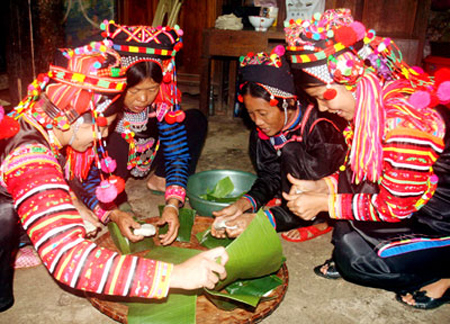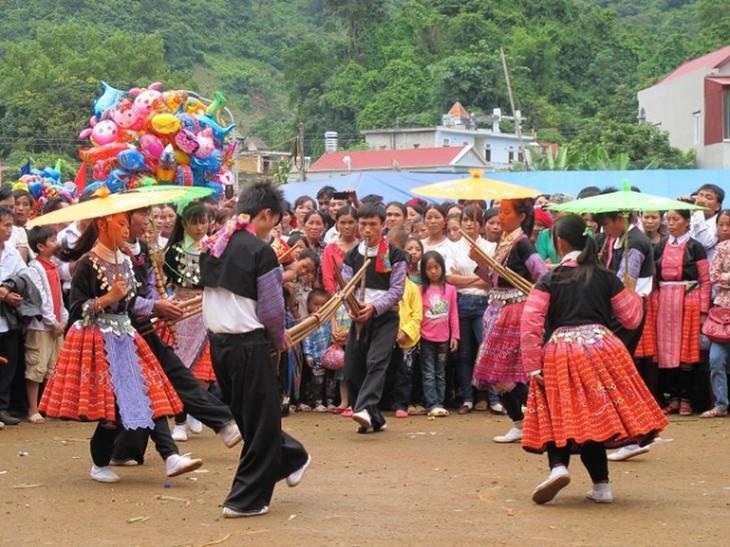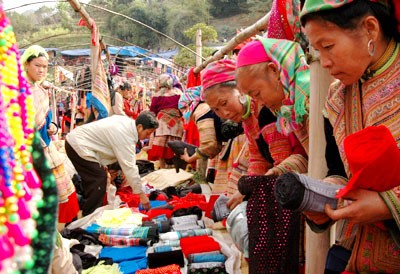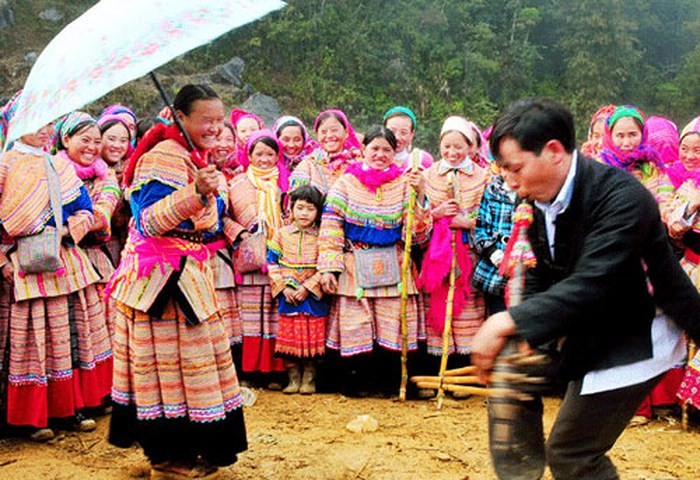(VOVWORLD) - The Mong people are an important partof the community of 54 ethnic groups in Vietnam, with a population of about one million people. They are often found the highland areas, mostly in northern mountain provinces of Ha Giang, Lao Cai, Lai Chau, Son La and a few in the Central Highlands. The best time to visit the Mong is during the Lunar New Year in late January or early February, when they celebrate Tet festival.
The New Year celebration of the Mong begins on the 30th day of the 11th lunar month and lasts for many days. It’s a time for entertainment and social engagement after a year of hard work.
Moc Chau district has 5 Mong hamlets. Whenever spring comes, they celebrate the New Year holiday with all the traditional character. They use home grown plants and animals raised by their hand to make worship offerings for genies and ancestors and pray for a better year.
 Mong women prepare food and offering. Mong women prepare food and offering.
|
Pham Van Giang, a Mong man in Dong Sang commune, said: “The Mong’s New Year celebration has maintained the old customs, particularly culinary culture. They cook the offerings and meals from what they raise and plant such as pigs, chicken, rice, and vegetables. They make their own clothes for Tet. This is a time for people to meet each other and tighten the community bond. After 2 main days of Tet, people cheerfully join in sports and cultural activities.”
Round glutinous rice cake is indispensible in their Tet meal. After Mong women steam glutinous rice, young men will use pestles to pound steamed rice in a wood mortar. Aromatic rice cakes are placed on the altars to show gratitude to their ancestors and genies for blessing them with a good crop. It’s also a special treat for guests during Tet.
Vu A Sua lives in Kho Tong hamlet: “We must have rice cakes to worship our ancestors during Tet. We also have big meals with pork and chicken. People play games together such as shooting crossbows and singing. My family is very happy.”
 They dance, sing, and play Khen pan-pipe during Tet. They dance, sing, and play Khen pan-pipe during Tet.
|
Depending on family conditions, they will have a Tet meal on a different day. Vang Thi Xiu in Dong Sang commune told VOV: “We make traditional dishes for Tet such as glutinous rice cakes and prepare pork and chicken. We visit all families in the hamlet to wish them happiness, good health, and good business.”
When economic life has become better-off, their cultural life is reciprocally improved. The Mong think that after a year of hard work, Tet is the time to relax and review what they have done. Young Mong men and women gather in the community yard to sing, dance, and play games. Passing Pa Pao balls is the most popular game. Players transfer a colorful cloth ball to each other and each one must try not to miss or drop it. Vang Thi Xiu introduces: “During Tet holiday, we have many games such as transferring Pa Pao balls and hitting humming tops. Young and old people play together. We stop all work to play, enjoy meals, and visit families.”
Transferring the Pa Pao ball is a game of young Mong women and men to share love. They believe that the New Year Festival is an opportunity for young people to find love.
During Tet, the Mong stick votive papers on farm tools to ward off bad luck of the old year. The farm tools are placed near the altars as a sign of paying gratitude to the plough, rakes, knives, and hammers for helping them grow plants and produce food. The Mong believe that everything has a soul. The farm tools earn pride of place near the altars, since they will continue to support the people and enable them to have a better year.
 Mong people love to go to market fair during Tet. Mong people love to go to market fair during Tet.
|
The Mong consider the panpipe the most important musical instruments in their culture and religious life. At festivals or fairs, the sound of the panpipe speaks of the Mong men’s sentiment for the girl he loves. In the context of modern life and tourism, the authorities of Dien Bien province and Mong artisans have made efforts to preserve the Mong panpipe.
Arriving in Tua Chua district, the rhythmic sound of the Mong panpipe carrying in the wind leads us to the stilt house of Giang A Su. He is one of a few Mong artisans who can both make a panpipe and play it. Sitting under the house’s eaves, the 80-year-old man is repairing a panpipe. He said the panpipe has nurtured his soul since he was a boy all the way up to the present day.
 |
Su said he watched his father making the panpipe and playing it since he was small. At the age of 17, he made his first complete panpipe. For more than 10 years later, he tried to master his skills and express his innermost feeling on every panpipe he made to produce the best sound. Su said he has never claimed the title of panpipe artisan. Besides skills, diligence, and knowledge of Mong culture, the maker should aim to imprint his soul on the work. "I started making panpipes when I was about 17 years old. I was young and didn’t have money to buy one. I learned to make it. Now that I’m old with poor eye-sight, I transferred the craft to my son. He will teach his children to keep the tradition alive.”
Because of the demanding work of making panpipes, only Giang A Khay, one of Su’s 4 sons, follows the craft. Su has always advised his son as to the proper sound of the panpipe. For his family and the Mong, the panpipe is not simply a musical instrument to express their emotions, it’s a channel to connect the waking world and the beyond. It’s enough of a priority that Mong families have always tried to preserve the panpipe wherever they migrate to.
Giàng A Khày, said: "When I was small, I watched my father and imitated him in making the panpipe. I’m willing to teach anyone who wants to learn how to make the panpipe to promote our people’s culture. The panpipe is very important for us. Playing the panpipe at a love market or art performance is fundamental to our culture. More importantly, we play it in funeral ceremonies to help the mourners and the deceased communicate.”
There are two panpipe workshops in Tua Chua in Dien Bien province and adjacent localities. Tua Chua district has successfully run a project to restore the Mong panpipe culture, including making and blowing the panpipe and engaging in the panpipe dance. Dien Bien authorities have organized spring and cultural festivals for young Mong people from other provinces to exchange and promote the panpipe in their community.
Vừ A Ký, a cultural official of Tua Chua district, said: “Tua Chua district has organized two classes to teach panpipe culture. Giang A Su was given the title of artisan at a national level in 2014. The Cultural Office and other sectors have tried to promote the Mong culture and the panpipe, an indispensible musical instrument in their culture.”
Tủa Chùa district is a land of rugged rocks. The Mong account for 70% of Dien Bien’s population. Despite social changes, the Mong still like to play the panpipe, dance to its celebrated sound, and listen as it paints an aural history of the Mong’s motherhood, brotherhood, and lifestyle.